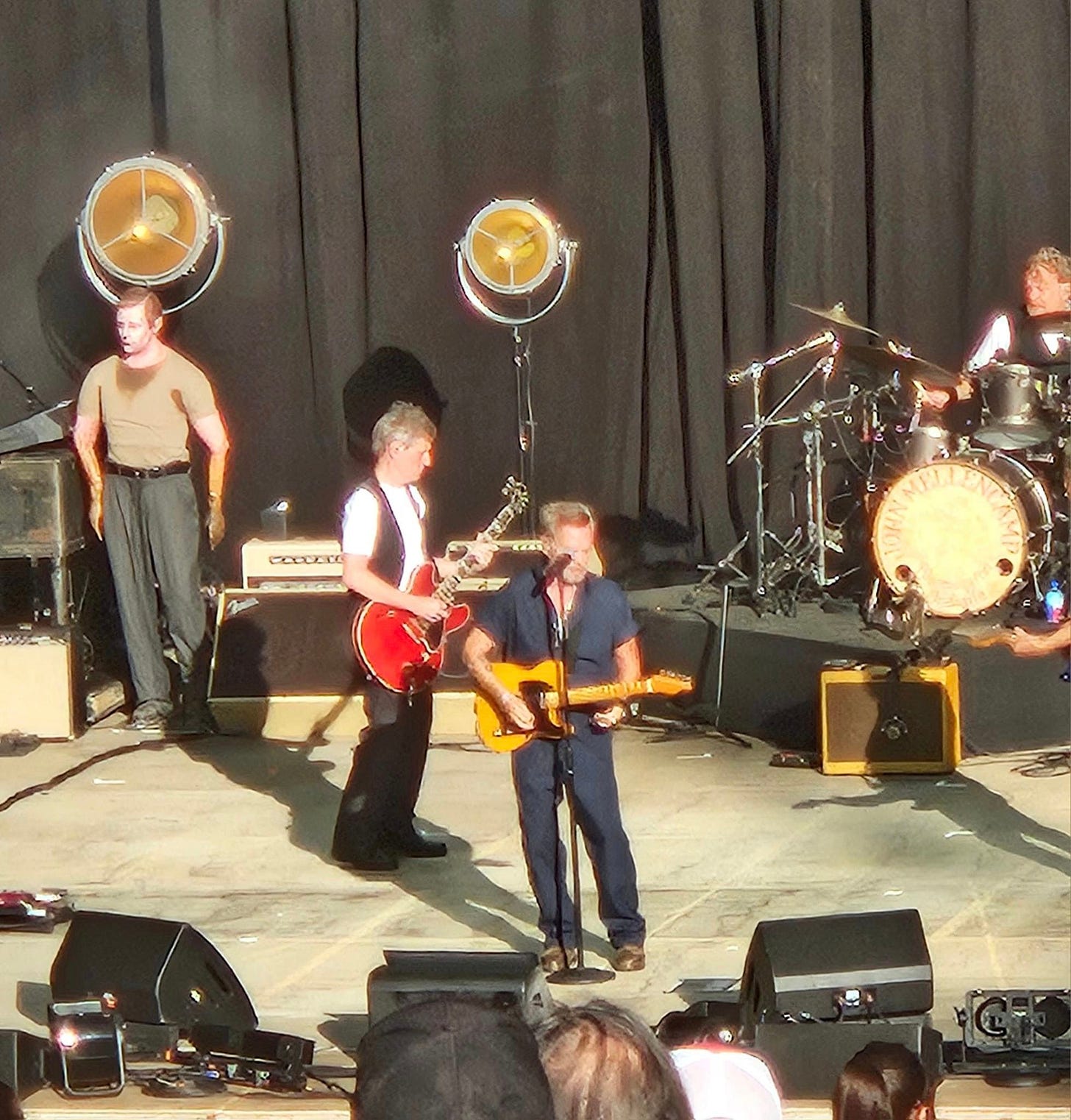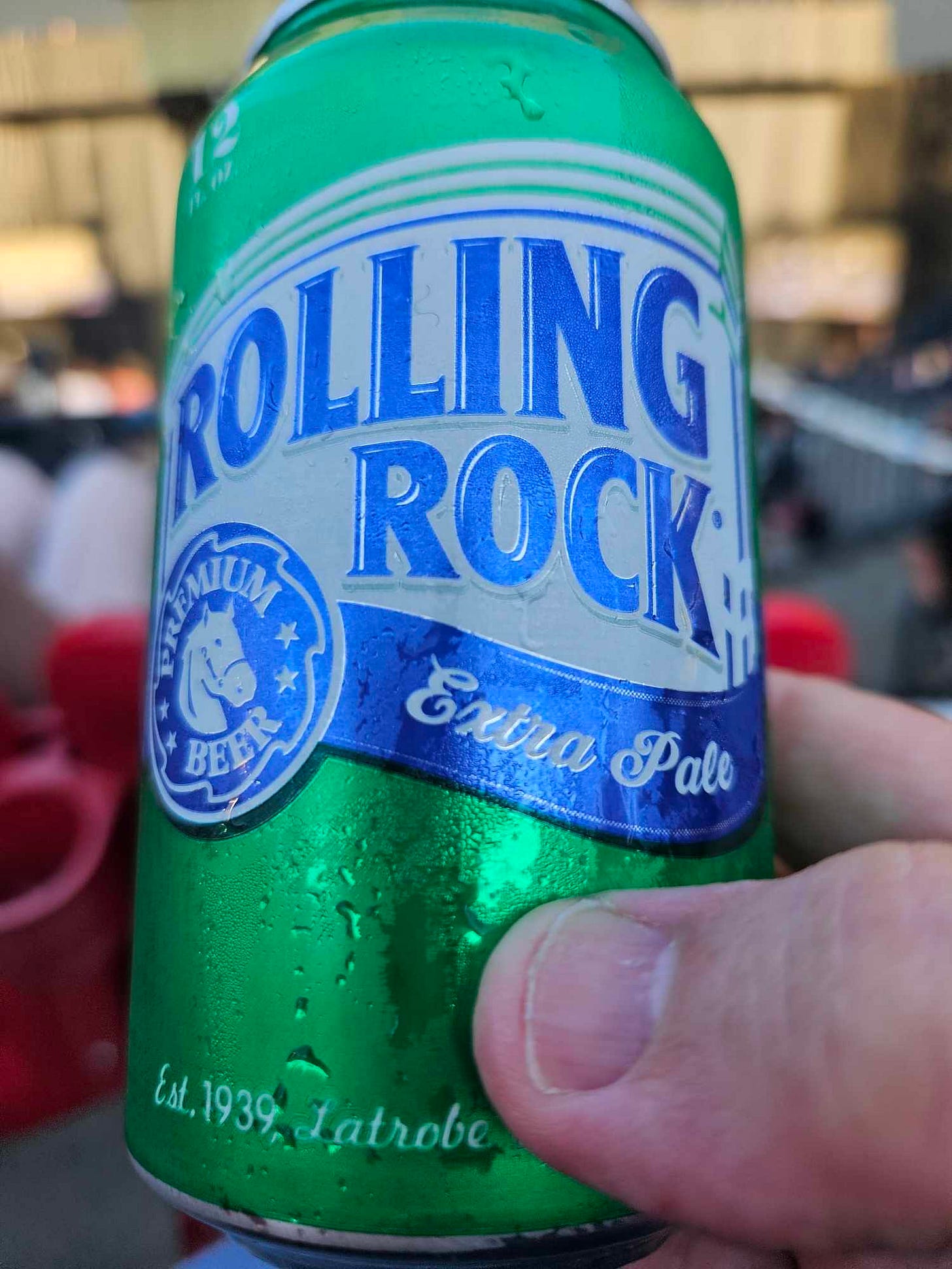Miracle workers
John Cougar, Bob Dylan and Willie Nelson at The Outlaw Festival, Shoreline Amphitheater, August 3, 2024
The other night Bob Dylan and Willie Nelson were playing in my neighborhood. I wasn’t prepared to drop $80 on them, but I thought maybe if I went there and hung around for long enough someone might hand me a ticket. So around 5 o clock I made my way across the Google campus, past all the goofy light sculptures and the light-up pedicabs, and when I got to the front of the arena where the box office is, I sat on a little low wall and directed people as they puzzled out the entry system. I felt I was putting my past life as a rock critic to good use.
“That way is shorter, but that way is shadier,” I’d tell people as they arrived, pointing in both directions like the Scarecrow in the Wizard of Oz.
Presently a man in an electric wheelchair approached, and I said, “That way is the ADA line.”
“Wow, thanks,” he said. “Are you official?”
Me, shrugging: “Nah, just sitting here waiting for a miracle.”
Immediately, several heads snapped round, and within minutes I had a ticket transferred to my phone – and not just any ticket, but a really good seat ticket. Free.
This show was billed as the Outlaw Festival – four acts, starting at 5 pm – and the grouping reminded me of two specific things: the 2016 Festival once dubbed “Oldchella,” and the now defunct local radio station called KFAT, whose playlist invented this audience by fusing a particular set of country, rock, and blues acts which appealed to a demographic that was made up of blue collar, working class, army veterans types who were also, strangely, liberal.
One person who was a big fan of KFAT was Steve Wozniak. In his book “IWoz” he talks about how KFAT heavily influenced him in his Apple days, as he listened to the radio while driving around the Santa Clara valley. “This was a strange new type of music I’d never been exposed to before – a lot of folk, a lot of country, a lot of comedy. It wasn’t some dumb old country-ish beat and song and themes; these songs were a lot about life. They very much reminded me of the sort of thinking Bob Dylan did, being as familiar with his lyrics as I was. And these songs went as deep -- they pointed out what was right and wrong in life.” *
KFAT went under and became KPIG, a station which is still a lot of fun to tune into if you’re in SLO or Santa Cruz, and which I bet a lot of the Outlaw Country attendees listen to. As for Oldchella (actual name: Desert Days): it took place at Coachella’s site, in October of 2016, and featured Bob Dylan, Neil Young, Paul McCartney, Roger Waters and the Rolling Stones. At it, Neil sang “Harvest Moon” under a Harvest (Hunter’s) Moon, Paul dueted on a song with Rihanna, The Stones covered a Beatles song and Waters denounced the Republican presidential nominee. But in addition to sounding pretty fab overall, it was a bill that taught the concert industry that older people would go see live rock – and pay up for it.
Hence: The Outlaw Festival. Oldchella featured a bunch of acts in their 70s, which seemed shocking at the time, but the headliner of this year’s Outlaw Festival is 91 and Dylan is 83. Little Johnny Cougar (that’s what I call John Mellencamp – because I am old too) is a mere 72. (Brittney Spencer is 35, but I missed her opening set.) I had a fair chance to do a lot of people watching whilst on that wall, and what I saw was a fair number of people who were contemporaries of the artists, but also many people in their 40s and 50s, lots of women in pairs, and also grandfathers with their sons and even grandsons. Also, tons of Dead Heads, or whatever that means nowadays, which isn’t the same as what it meant in my day.
So’s anyway, I got into the festival just as John Cougar was taking the stage. He played a set that was pretty much exactly the same as the one I saw him play last time – in the 1990s, at the Oakland Coliseum. I had forgotten how many hits this guy had – or quite how workmanlike he is. I remember back then reading a Village Voice article headlined “Indiana’s Springsteen,” and that seems right, only with songs that are…do I dare write this…more enjoyable?
Obviously, that couldn’t be true, but what is true is that Mellencamp’s songs wallow down in the same place as Bruce does. They describe small-town, blue collar life and encase them in a similar tempo and chord set, adding a violin and a few other flourishes before spitting them back in a simpler, more homely and maybe even more tuneful form. Thus, “Born in the USA” becomes “Little Pink Houses,” and although I am not going to say which it is, only one of those songs is more or less unlistenable.
I am not going to defend the Mellencamp catalog en masse, but I will admit to finding his set appealing. I liked that he still had his voice. And that he had the same violinist, Lisa Germano, as when I last saw him. The crowd liked him too, I should add. Despite having worked mostly in the pop idiom, he kind of epitomizes the attitude of ‘Outlaw Country.” Plain. Old. Rock. N. Roll.
Next up was Bob Dylan, who’s whole set was marred for me by the fact that two drunk women in kaftans were now seated next to me “chomping,” which is Dead-speak for people who talk through the music. In this case, talking to me. They had a lot to say, too, about this and that, but their main thing was to complain vociferously that Bob Dylan was not being displayed in close up on the video screen. Jeez, you would have thought the world was ending, they were so mad about this fact.
“I mean, how do we even know it really IS Bob Dylan?” one of the ladies griped, and I had to laugh, because Bob Dylan’s voice is so unique, his cadences are so distinctive, and the man on stage in the beanie hat was most definitely Bob Dylan. Also: who else knows all the verses to “Ballad of the Thin Man”?
Truthfully, her case had some merit in that the long-distance shots were vague and disconcerting and the set he played was lacking in anything recognizable to a person who probably only knows his hits. There were songs from “Highway 61 Revisited,” “Blood on the Tracks,” “Oh Mercy,” “Tempest,” and even other albums, as well as some wacky cover choices (Chuck Berry, the Dead, the Fontanes); there was a guest guitarist, Elvin Bishop; there was blues, there was crooning, there was honky-tonk. There was a standup bass. There was that vintage Dylan sing-song sound, in which his odd voice kind of mimics the 12-bar pattern only without the, for lack of a better word, ethnicity? Personally, I enjoyed it, but I too was unfamiliar with a lot of the material, and I would have liked it more if there wasn’t a lady in an orange kaftan bellowing “CLOSE-UP!!” in my ear the entire time.
After the set was over, she actually went up to the cameraperson to complain, and he told her Bob Dylan didn’t want closeups (this has been his policy for years, apparently). Willie Nelson didn’t mind them, I’m happy to say, so she was able to be sure that it was really him. I truly feel I would have known it was him without seeing him, but in these days of AI, I guess it doesn’t do to be too gullible.
Willie was good, I enjoyed most of his set before I jumped early to avoid crowds. Later my brother noted that Willie Nelson was born in 1933 and was raised by his grandparents, meaning that he grew up in a household run by two people (musicians, in fact) from the 19th century. For some reason, that makes it feel even more remarkable that he’s performing at age 91 and that we get to see him, but it’s also really hard to fathom. As the caftan lady remarked, his presence is somewhat reminiscent of a certain raft of old white guys who stay in their jobs for longer than is necessary. “They hate to quit,” she said, “because they love their work.” It’s sure is cool that some people feel that way about their jobs, but I wonder how many of the rest of us would just prefer to stop our toil.
excerpted from my book “Half a Million Strong.”







I love that you went and I'm super jealous that you got a free ticket!